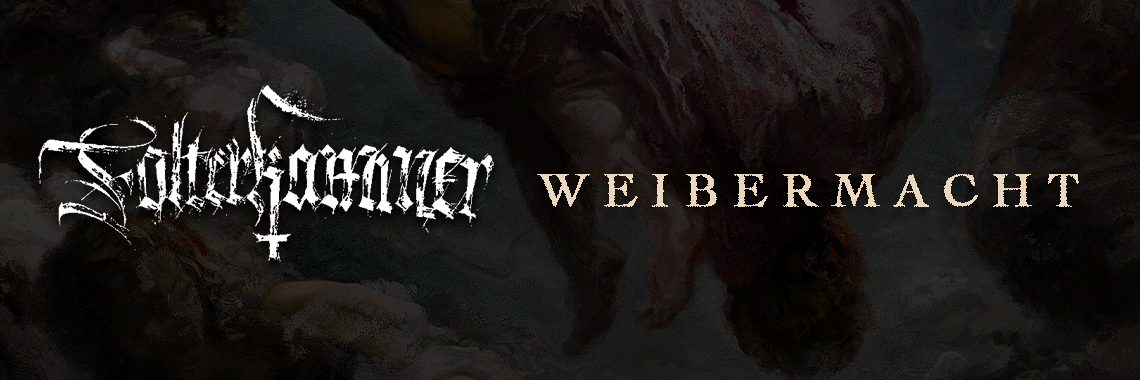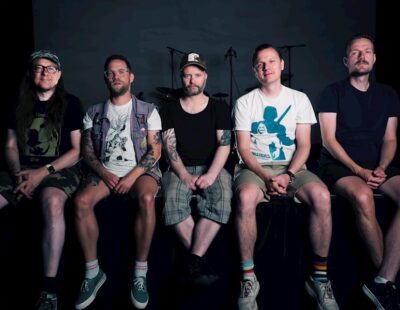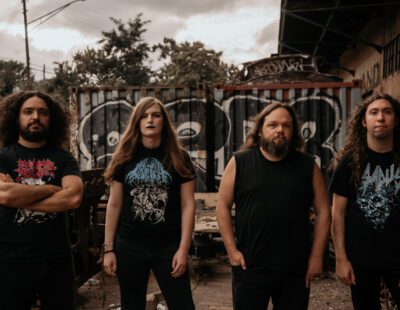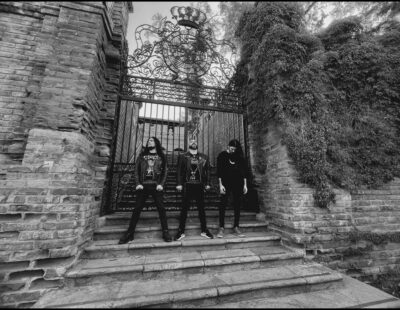We’re obviously not breaking the news that Riot guitarist, Mark Reale (far L in photo), passed away on January 25 from complications from Crohn’s disease. Nonetheless, we wanted to pay tribute to a musician—and more importantly, a band—that hasn’t gotten his/their due in American metal history. Reale was not only a founding member of Riot, he was the primary songwriter in the band. Though we would have argued fervently to have the band’s third album, Fire Down Under, inducted into Decibel’s Hall of Fame, original lead vocalist Guy Speranza, unfortunately, preceded Reale in death in 2003, thus eliminating the band for consideration.
Riot started in NYC in the mid-’70s when there wasn’t much in the way of hard rock or metal in the States. The UK had any number of different purveyors, but we had the likes of KISS, Nugent, Montrose, Heart, Angel, Aerosmith, et al. It wasn’t entirely bleak, but it wasn’t super inspiring either. No surprise, then that Riot didn’t exactly have labels champing at the bit to sign them.
Their first album, Rock City, arrived in 1977, via Fire Sign Records, their own management’s label. It was licensed to Canadian and Japanese labels, but American labels had no interest. Metal Blade eventually reissued it in 1993, and while it’s not the band at its best—the limp ’70s production doesn’t help either—it’s pretty clear that Riot were following a different path.
“Warrior” from Rock City
Japan actually caught on to Riot long before the States ever did. The band’s second album, named after the Japanese airport Narita was first issued in Japan and then snapped up by Capitol for a major label release in America. That was to be the first and last record the band did for Capitol who clearly had no idea what kind of band they had. Capitol wanted something commercial, and Riot wanted to blow doors.
“Road Racing” (live) from Narita (and Riot Live)
Riot actually recorded their third album, Fire Down Under, while under contract to Capitol, but the label didn’t appreciate the band’s increasingly heavy direction and opted to drop them. Their loss was Elektra’s gain. Fire Down Under, released in 1981, didn’t sell a million copies (though it did chart in the Billboard Top 100), but it’s one of the greatest American metal releases of the era, easily standing toe to toe with their NWOBHM contemporaries of the day.
Just check out what they’re laying down in this Long Island club gig in 1981 (below). This 57-minute video is perhaps the best document of this lineup’s power, focus and energy. Fire Down Under is an essential example—along with Y&T’s Earthshaker—of US bands rising to the challenge of the NWOBHM. It was that all-important make-or-break third album (like Earthshaker) and Riot delivered. Unfortunately any momentum they may have had was lost when Speranza packed it in shortly after the album’s release.
Live club gig circa Fire Down Under
Riot was undeterred, however, and found a Georgia-born Southern belter named Rhett Forrester to take Speranza’s place. This, however, was the beginning of the end of this incarnation of Riot. While Forrester was a strong vocalist and his Southern drawl meshed surprisingly well with Riot’s music, Restless Breed (1982) failed to sell as well as its predecessor (despite its more commercial leanings) and the band left Elektra. The follow-up, Born in America, appeared on Candian indie Quality records in 1983, and shortly thereafter Riot disintegrated. (Forrester was killed by a carjacker a decade later, when he refused to relinquish his vehicle to the criminal.)
“Loanshark” from Restless Breed
Mark Reale, unlike his former band mates, refused to throw in the towel. He moved to Texas and continued to play music, though initially not as Riot. That is until 1988 when he re-emerged with an entirely new Riot lineup (that included drum wiz Bobby Jarzombek) completely devoid of any original members, save for Reale himself. They issued the Thundersteel album on CBS and have continued, more or less (and with numerous lineup changes), until Reale’s death. They were, in fact, just about to tour in support of their latest, Immortal Soul.
To be honest, the late-’80s-and-beyond, power metal version of Riot didn’t have the same appeal to us. It was an entirely band literally and figuratively. Reale’s playing remained stellar, but the vibe was different. Gone was the rough, street-wise NYC vibe, replaced by, well, this.
“Bloodstreets” from Thundersteel
Regardless, the Riot of 1977-1983, five albums in all, gave American metal a well-deserved kick in the ass at a crucial time. Ask any metal musician who came up in the era and they’ll tell you that those albums, particularly Fire Down Under, were important releases. So, we’ll leave you with this—one of our favorite Riot tracks—as well as our condolences to Mark Reale’s family and friends, and his numerous former band mates. The original Riot was an amazing band that deserves to be remembered. Rest in peace, Mark.
“Fire Down Under”






